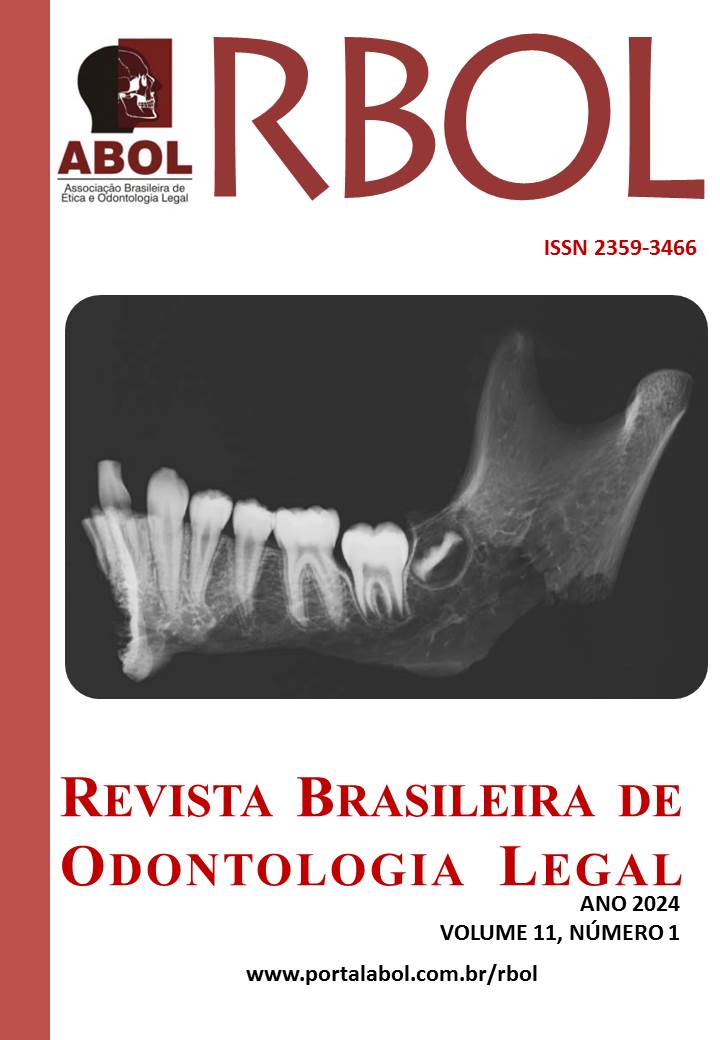ANÁLISE DA PERFORMANCE DE GRADUANDOS INGRESSANTES E CONCLUINTES DO CURSO DE ODONTOLOGIA NA IDENTIFICAÇÃO HUMANA PELA ANÁLISE DE FOTOGRAFIAS DO SORRISO
DOI:
https://doi.org/10.21117/rbol-v11n12024-516Keywords:
Odontologia Legal, Antropologia Forense, Fotografias do Sorriso.Abstract
Introduction: Teeth are invaluable organs for human identification, as they are the most stable, hard and resistant structures in the body. With the progressive use of digital cameras to capture social photographs, such as the "selfie", in which the main focus is on the individual's face, these photographs are able to provide material capable of solving human identification cases. Objective: To demonstrate the importance of smile photographs in the process of human identification and to compare and verify the performance of undergraduate dental students (beginners and graduates) in human identification using smile analysis. Material and Methods: This study used the methodology and image bank of the work by SILVA R.F. et al. (2012), and the target audience that evaluated the images, modified. Each student participating in the study analyzed a group of 4 projected images, 2 of which were smiles (A and B) and 2 intraoral (C and D). Of the 10 provided for each image group, only one was compatible with each projected photograph. Results: After analyzing the data, it was possible to see that 84.6% of the incoming students (26 students) got tests A and B right, and 95.6% of the outgoing students (23) got tests A and B right. In test C we can see that 61.5% of incoming students got the test right, and 69.6% of outgoing students got it right. And finally, test D showed that the entrants got a total of 80.8% right, while all the graduates (100%) got test D right. The most cited parameters were tooth color, tooth inclination, incisal morphology and incisal alignment. Conclusion: In this study, both new students and graduates demonstrated their ability to analyze smile photographs in human identification. The new students had a higher number of errors, due to the fact that they did not yet have in-depth theoretical and technical knowledge of anatomy, making this a difference between new students and graduates.
Downloads
Published
Issue
Section
License
Os autores deverão encaminhar por email, devidamente assinada pelos autores ou pelo autor responsável pelo trabalho, a declaração de responsabilidade e transferência de direitos autorais para a RBOL, conforme modelo abaixo.
DECLARAÇÃO DE RESPONSABILIDADE E TRANSFERÊNCIA DE DIREITOS AUTORAIS
Eu (Nós), listar os nomes completos dos autores, transfiro(rimos) todos os direitos autorais do artigo intitulado: colocar o título à Revista Brasileira de Odontologia Legal - RBOL.
Declaro(amos) que o trabalho mencionado é original, não é resultante de plágio, que não foi publicado e não está sendo considerado para publicação em outra revista, quer seja no formato impresso ou no eletrônico.
Declaro(amos) que o presente trabalho não apresenta conflitos de interesse pessoais, empresariais ou governamentais que poderiam comprometer a obtenção e divulgação dos resultados bem como a discussão e conclusão do estudo.
Declaro(amos) que o presente trabalho foi totalmente custeado por seus autores. Em caso de financiamento, identificar qual a empresa, governo ou agência financiadora.
Local, data, mês e ano.
Nome e assinatura do autor responsável (ou de todos os autores).

